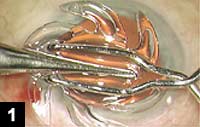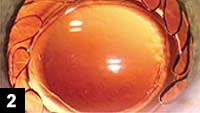Haptic system of the 360 SE lens provides a barrier to PCO
Once inside the bag, the haptics come into contact with each other and act as a tension ring.
NANTES, France — The shape and haptic system of a new IOL provides a barrier against posterior capsule opacification, according to a surgeon here.
“The 360 SE from Corneal SA is a new concept that uses a capsular tension ring effect. The lens is circular, filling the capsular bag better than any other lens currently on the market,” Philippe Sourdille, MD, told Ocular Surgery News.
|
|
Six identical loops
The main difference between this lens and others is the presence of six identical loops.
“The six haptics come into contact after in-the-bag placement and form a circular and closed capsular tension ring,” Dr. Sourdille said.
The ring is formed from open loops and can adapt to different bag diameters, according to a product dossier. The memory of the flexible material and the geometry of the haptics allow the lens to adjust to the bag.
The lens is made of a hydrophilic acrylic material.
“We chose this for its physical qualities: resistance to tearing, foldability and compressibility,” Dr. Sourdille said.
It is a one-piece IOL, with 10% posterior angulation of the haptics, to guarantee consistent IOL placement, posterior capsular contact and capsular bending, he said.
Less lens material is accumulated because the haptics also occupy the space between the equator of the lens and the periphery of the IOL optic, Dr. Sourdille said.
Three levels of PCO
There are three “levels” at which PCO can be stopped, Dr. Sourdille said. One is at the equator of the capsular bag (tension ring effect), the second is in between the equator and the IOL and the third is at the IOL-optic edge.
“This lens applies sharp-edge technology on both optic and haptics,” he said.
7 keys to keeping the capsular bag transparent
|
According to a representative of Corneal, sharp-edge technology is a combination of several characteristics: a sharp edge all around the optic, even at the optic/haptic junction, an angulation to obtain contact from the optic with the posterior capsule and a constant posterior curvature of the optic.
The capsular-tension-ring effect of haptics coming into contact acts to prevent posterior capsule folds and diminish the distance between the posterior capsule and the IOL, he said.
To implant the lens, the surgeon can inject it through a conventional 3.2-mm incision. As with any IOL that is angulated, the surgeon must check that the lens is correctly oriented (clockwise) before closing the injector, he said.
Dr. Sourdille has implanted more than 300 eyes with the 360 SE and has had no IOL-related complications. “We could achieved our goals with the lens: perfect centration, no capsular folds, no PCO, transparent anterior capsule,” he said.
“Additionally, we have had no Nd:YAG capsulotomies after more than 2 years of follow-up. In 2% of cases, one of the six haptics overlapped the next haptic, without any consequences. The volume of the IOL seems to prevent the formation of newly formed lens material in the whole capsular bag,” he explained.
Anterior capsule opacification
Even with lens technology and materials helping to solve the problem of PCO, surgeons are still left with complications related to anterior capsule opacification, Dr. Sourdille said. Opacification and shrinkage occur from the contact between the anterior capsule and the IOL optic.
Under certain clinical conditions, lens epithelial cells can also migrate onto the surface of the anterior capsule, causing capsulophimosis, he said. This can result in blood-aqueous barrier rupture, traction on the ciliary body and hypotony, as well as tilt and decentration of the lens, he said.
“To date, this the only IOL that consistently keeps the anterior capsule transparent by preventing anterior capsule and IOL optic contact,” he said.
“Delaying or even preventing anterior capsule/IOL contact seems to play an important role in avoiding anterior-capsule-related complications. Combining sharp-edge technology, posterior angulation of the haptics, capsular-tension-ring effect and long-lasting noncontact of the anterior capsule to the IOL optic seems to increase capsular bag transparency,” Dr. Sourdille said.
For Your Information:
- Philippe Sourdille, MD, can be reached at Clinique Sourdille, 8 Rue Camille Flammarion, 44000 Nantes, France; +(33) 251-83-32-00; fax: +(33) 251-83-87-19; e-mail: philippe.sourdille@wanadoo.fr. Dr. Sourdille has no direct financial interest in the product mentioned in this article. He is a paid consultant for Corneal SA.
- Corneal SA, manufacturer of the 360 SE IOL, can be reached at 31 Rue des Colonnes, 75012 Paris, France; +(33) 1-43-42-9393; fax: +(33) 1-43-07-0190; e-mail: export@corneal.com.


